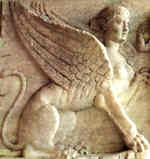| Gorgon
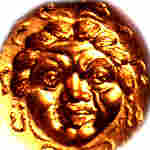 One
of the three terrible sisters - usually the most famous one, Medusa - that
resided at the westernmost land of sunset in the Ocean, and whose legendary
ugliness turned men to stone when glanced at directly. Serpents for hair,
boarlike teeth, a mad grin and glow in the eyes - all these are Gorgon's
features, which, so depicted, stared at owners of coins issued at more
than two dozen Greek cities ranging from Sicily to the Black Sea (albeit
with less petrifying consequences). Tales of her taming differ, but in
the most common one the hero Perseus, aiding his courage with Athena's
mirror-like shield, manages to cut Medusa's head off into a sack. Since
then, her facing image appears on this shield - under the name Gorgoneion
- as a weapon, or charm of sorts, against other evils. Ironically, the
modern Greek word "gorgona" follows possibly a later legend, and signifies
quite the opposite of the petrifying ugliness of Medusa and her companions
- the cold (and sometimes still quite torturous) beauty and grace of a
mermaid. Or, perhaps it originates in the initial appearance of Gorgon,
who once was a beautiful centaur whom even Poseidon couldn't resist; their
joint pleasure in Athena's temple was an act of sacrilege that the goddess
was to punish severely for the non-divine of the two, with known consequences.
Lastly, it is interesting to note that this original form of Medusa can
be found - crude and rare, but yet, of all places - on certain medieval
Russian coins, her fame probably passed down with the written tales of
the great Alexander. One
of the three terrible sisters - usually the most famous one, Medusa - that
resided at the westernmost land of sunset in the Ocean, and whose legendary
ugliness turned men to stone when glanced at directly. Serpents for hair,
boarlike teeth, a mad grin and glow in the eyes - all these are Gorgon's
features, which, so depicted, stared at owners of coins issued at more
than two dozen Greek cities ranging from Sicily to the Black Sea (albeit
with less petrifying consequences). Tales of her taming differ, but in
the most common one the hero Perseus, aiding his courage with Athena's
mirror-like shield, manages to cut Medusa's head off into a sack. Since
then, her facing image appears on this shield - under the name Gorgoneion
- as a weapon, or charm of sorts, against other evils. Ironically, the
modern Greek word "gorgona" follows possibly a later legend, and signifies
quite the opposite of the petrifying ugliness of Medusa and her companions
- the cold (and sometimes still quite torturous) beauty and grace of a
mermaid. Or, perhaps it originates in the initial appearance of Gorgon,
who once was a beautiful centaur whom even Poseidon couldn't resist; their
joint pleasure in Athena's temple was an act of sacrilege that the goddess
was to punish severely for the non-divine of the two, with known consequences.
Lastly, it is interesting to note that this original form of Medusa can
be found - crude and rare, but yet, of all places - on certain medieval
Russian coins, her fame probably passed down with the written tales of
the great Alexander.
|
Pegasos
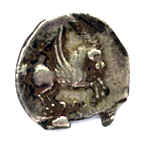 The
tale of the famous winged horse of antiquity starts exactly where the main
story of the abominable Medusa ends - from the blood in the beheaded body
of the monster sprung Pegasos, the fruit of an illicit affair between Medusa
and Poseidon. He is most noted as the fateful horse accompanying the hero
Bellerophon, in feats like the slaying of another terrible monster,
the fire-breathing Chimaira. But Pegasos throws off and abandons his master
as he attempts to soar up Mt. Olympos and join the gods - "the bitter end",
according to ancient writer Pindar, "that awaits one who seeks more than
is right". Pegasos appears relatively frequently on Greek issues, the most
notable of which are the famous Corinthian staters. The
tale of the famous winged horse of antiquity starts exactly where the main
story of the abominable Medusa ends - from the blood in the beheaded body
of the monster sprung Pegasos, the fruit of an illicit affair between Medusa
and Poseidon. He is most noted as the fateful horse accompanying the hero
Bellerophon, in feats like the slaying of another terrible monster,
the fire-breathing Chimaira. But Pegasos throws off and abandons his master
as he attempts to soar up Mt. Olympos and join the gods - "the bitter end",
according to ancient writer Pindar, "that awaits one who seeks more than
is right". Pegasos appears relatively frequently on Greek issues, the most
notable of which are the famous Corinthian staters.
Pan
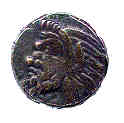 The
god of shepherds and flocks, son of Hermes (according to one tradition).
Mostly appearing human, but usually with horns, ears, legs and hair of
a goat, he was fond of music and played a characteristic multiple pipe,
which to this day is called panpipe. But his most lasting legacy is that
of panic - the utter terror inflicted on unsuspecting travellers in the
woods with his shrieky voice. He is credited with pulling the same move
on the Persian invaders at Marathon - and was venerated by the Athenians
for that memorable deed. The
god of shepherds and flocks, son of Hermes (according to one tradition).
Mostly appearing human, but usually with horns, ears, legs and hair of
a goat, he was fond of music and played a characteristic multiple pipe,
which to this day is called panpipe. But his most lasting legacy is that
of panic - the utter terror inflicted on unsuspecting travellers in the
woods with his shrieky voice. He is credited with pulling the same move
on the Persian invaders at Marathon - and was venerated by the Athenians
for that memorable deed.
|
| Satyr
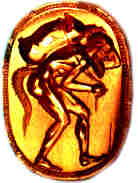 Somewhat
resembling Pan, both in appearance and in their association with the Dionysiac
rituals, are these pleasure-seeking but timid deamons of the woods. Confused
occasionally later with a selinos, the satyr's artistic representations varied
from early, more goatlike-versions, to the largely anthropomorphic ones,
exemplified by the classic sculpture of master Praxiteles. Yet, some of
the more memorable renditions are those found on archaic coins of Thasos,
with running satyrs, sometimes "ithyphallic" (sexually aroused), in the
charming scene where one tries to run away with a protesting nymph. Some
satyrs achieved considerable prominence - like in the case of Marsyas,
known for his legendary musical competition with Apollo (which he lost,
naturally, and with grave consequences), and represented on coinage in
both Greece and Rome. Somewhat
resembling Pan, both in appearance and in their association with the Dionysiac
rituals, are these pleasure-seeking but timid deamons of the woods. Confused
occasionally later with a selinos, the satyr's artistic representations varied
from early, more goatlike-versions, to the largely anthropomorphic ones,
exemplified by the classic sculpture of master Praxiteles. Yet, some of
the more memorable renditions are those found on archaic coins of Thasos,
with running satyrs, sometimes "ithyphallic" (sexually aroused), in the
charming scene where one tries to run away with a protesting nymph. Some
satyrs achieved considerable prominence - like in the case of Marsyas,
known for his legendary musical competition with Apollo (which he lost,
naturally, and with grave consequences), and represented on coinage in
both Greece and Rome.
|
Centaur
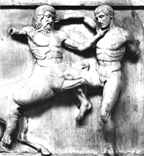 Another kind of mischievous character to be found in Dionysos' orgiastic entourage, among numerous other mythological contexts. Creatures with a human head-torso planted onto a horse's body, centaurs rose from their legendary birthplace in ancient Thessaly to a popularity which made them eventually transcend even Greek mythology. Most of them are known for their mean, wild and slovenly behavior. They often cross Herakles' path, and one of them, the vile Nessos, engineered a revenge for their earlier encounters which was finally to lead to Herakles' death. Ironically, the two noble and helpful centaurs, Cheiron and Pholos, both ended up as accidental casualties of Herakles' poison arrows following the latter's battle with the more "regular" (bad) centaurs, in one of his many episodes en route to capturing the Erymanthean boar. Another kind of mischievous character to be found in Dionysos' orgiastic entourage, among numerous other mythological contexts. Creatures with a human head-torso planted onto a horse's body, centaurs rose from their legendary birthplace in ancient Thessaly to a popularity which made them eventually transcend even Greek mythology. Most of them are known for their mean, wild and slovenly behavior. They often cross Herakles' path, and one of them, the vile Nessos, engineered a revenge for their earlier encounters which was finally to lead to Herakles' death. Ironically, the two noble and helpful centaurs, Cheiron and Pholos, both ended up as accidental casualties of Herakles' poison arrows following the latter's battle with the more "regular" (bad) centaurs, in one of his many episodes en route to capturing the Erymanthean boar.
|
